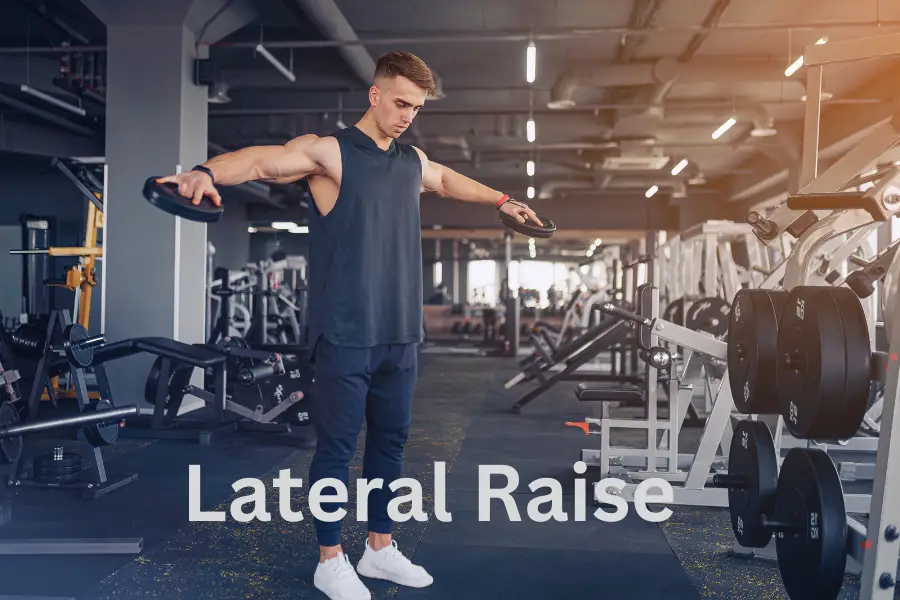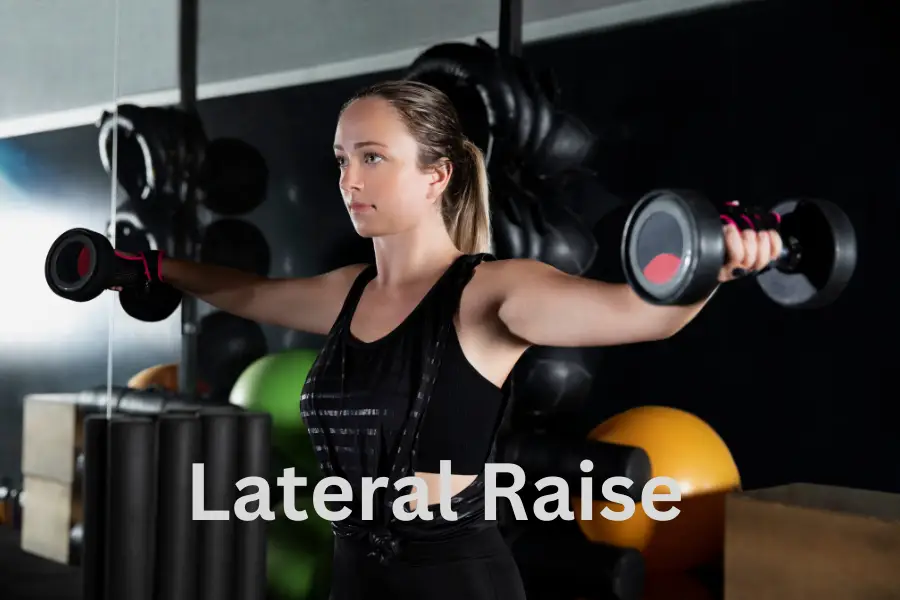Table of Contents
The lateral raise, a classic exercise in health and fitness, is surprisingly simple. It focuses on developing the shoulder muscles, particularly the lateral deltoid. This straightforward yet effective movement can transform your shoulders when done with proper form and consistency. Whether you’re a fitness enthusiast or someone looking to tone and strengthen your upper body, the lateral raise can be an integral part of your routine.
What is the Lateral Raise?
The lateral raise is an isolation exercise that primarily targets the lateral deltoid, one of the three parts of the shoulder muscle. By performing this exercise, individuals can build width and size in their shoulders, enhancing overall upper body aesthetics. The training involves lifting weights (usually dumbbells) out to the sides until your arms are parallel to the ground, then lowering them back down.
Benefits of Lateral Raises
Shoulder Definition: Builds round, defined shoulder muscles.
Improves Shoulder Stability: Strengthens muscles that support shoulder joints.
Increases Functional Strength: Useful for daily activities involving lifting.
By isolating the lateral deltoid, the lateral raise ensures you’re directly targeting this specific part of the shoulder without involving other muscle groups too much.
How to Perform Lateral Raise with Proper Form
The key to mastering the lateral raise is executing it with proper form. This detailed guide emphasises the importance of using the correct techniques to isolate the lateral deltoid muscle, which is crucial for building shoulder width and strength. It also helps to maximise the exercise’s effectiveness and minimise the risk of injury.
The key points include
Starting position
Standing with feet shoulder-width apart, holding dumbbells at your sides with a neutral grip, and engaging your core.
Raising the arms
Lifting the dumbbells out to the sides in a controlled motion until they reach shoulder height, ensuring that elbows are slightly bent.
Lowering the arms
Slowly lower the weights back down to the starting position to maintain tension on the shoulder muscles.
Common mistakes to avoid
Preventing errors like using excessive weight, swinging the body, or engaging traps and neck muscles instead of the deltoids.
Tips for Proper Form
Keep your back straight and engage your core for stability.
Avoid swinging the weights or using momentum.
Use a weight that allows you to control the movement throughout.
Common Mistakes to Avoid During Lateral Raises
While the lateral raise may seem simple, it’s crucial to be aware of and avoid several common mistakes. These errors can reduce the exercise’s effectiveness or even lead to injury, making it important to be cautious and attentive during your workout.
Common Mistakes
Using Too Much Weight
Lifting heavy weights can cause you to use momentum rather than muscle, reducing the effectiveness of the exercise.
Swinging the Weights
This usually happens when the weights are too heavy, leading to improper form.
Overextending the Arms
Raising the arms too high can strain the shoulder joints.
Neglecting Proper Tempo
Performing the raise too quickly can reduce the muscle’s time under tension, limiting gains.
Focus on controlled movements and choose a weight that allows you to complete the exercise with good form.
Variations of the Lateral Raise
Incorporating lateral raise variations can be beneficial for keeping your workouts exciting and targeting different aspects of your shoulder muscles.
Lateral Raise Variations
Dumbbell Lateral Raise
The most common variation, performed with dumbbells.
Cable Lateral Raise
Provides constant tension on the muscles throughout the movement, unlike dumbbells, where tension changes.
Machine Lateral Raise
Ensures strict form by eliminating the possibility of momentum.
Seated Lateral Raise
Removes the possibility of using your legs to assist in the lift, focusing entirely on your shoulders.
Each of these variations brings slight differences to the exercise, allowing for comprehensive shoulder development.
Muscles Worked During Lateral Raise
While the lateral raise primarily targets the lateral deltoid, it also engages other muscles to a lesser degree.

Primary Muscles Worked
Lateral Deltoid
The main target of the exercise, responsible for shoulder width.
Secondary Muscles Worked
Trapezius
Assists in stabilizing the shoulder blades during the movement.
Supraspinatus
Helps lift the arms during the first part of the motion.
By isolating the lateral deltoid, the lateral raise ensures that your shoulder muscles develop balance, contributing to a fuller and more rounded look.
Incorporating Lateral Raises into Your Workout Routine
Depending on your goals, the lateral raise can be included in various workout programs. Whether you aim to build muscle, improve endurance, or enhance functional strength, this exercise can be tailored to meet your needs.
Suggested Workouts
Hypertrophy (Muscle Growth)
3-4 sets of 8-12 reps with moderate to heavy weights.
Endurance
2-3 sets of 15-20 reps with lighter weights.
Strength
4-5 sets of 6-8 reps with heavier weights.
Consider incorporating lateral raises 2-3 times per week as part of your shoulder or upper body workout.
Advanced Tips for Mastering Lateral Raises
The Advanced Tips for Mastering Lateral Raises are techniques designed to help individuals who have mastered the lateral raise’s basic form and want to push their shoulder development further. These tips can increase the intensity, improve muscle engagement, and break through strength plateaus. Here’s a breakdown of these advanced strategies:
Eccentric Focus
Focusing on the movement’s eccentric (lowering) phase can significantly enhance muscle growth. In this technique, you slow down the lowering phase of the lateral raise, which increases the time under tension for your shoulder muscles, particularly the lateral deltoid. This extra focus on the negative portion of the rep helps to:
Build greater muscle strength and size.
Engage the muscle fibers more intensely.
Tip: Aim for a 3-5 second lowering phase after lifting the weights to shoulder height.
Partial Reps
Performing partial reps can help you push your muscles to fatigue when tired. These are small, controlled movements at the top or bottom range of the lateral raise. Partial reps help:
Target the lateral deltoids after the muscle is too tired to perform complete repetitions.
Increase muscle endurance and activate different muscle fibers.
Tip: After completing your full range of motion reps, add 5-10 partial reps to exhaust the shoulder muscles fully.
Supersets
In this case, you can pair lateral raises with a complementary shoulder exercise like shoulder presses or front raises. This helps:
Maximize muscle fatigue for better growth.
Increase the overall intensity of your shoulder workout.
Tip: For an effective superset, perform 10-12 lateral raises and immediately follow with 10-12 shoulder presses.
Drop Sets
A drop set involves performing a set of lateral raises until failure with a heavy weight, then immediately reducing the weight by 20-30% and continuing the exercise without rest. Drop sets help:
Increase muscle hypertrophy by exhausting the muscle fibers.
Push your shoulders beyond their typical limits.
Tip: Start with a heavier weight that you can manage for about 8-10 reps, then reduce the weight and perform another 8-10 reps.
Slow Tempo Reps
Slowing down the entire movement of the lateral raise—both the lifting and lowering phases—can enhance muscle engagement. Slow-tempo reps force your muscles to work harder during each part of the exercise, improving strength and endurance. This is beneficial for:
Building better mind-muscle connection, ensuring you’re targeting the lateral deltoids correctly.
Increasing the intensity of each repetition.
Tip: Perform each rep with a 3-4 second lift and a 3-4 second lower.
Unilateral Lateral Raises
Unilateral training involves working one side of your body at a time. Doing unilateral lateral raises can correct muscular imbalances, improve coordination, and focus more intensely on each shoulder. This technique helps:
Ensure both shoulders are equally developed.
Engage the core more for balance and stability.
Tip: Perform all reps on one side before switching to the other, controlling the movement.
Incorporating these advanced techniques into your routine can significantly elevate your shoulder workouts, enhance muscle development, and improve overall strength. They are instrumental if you’ve hit a plateau in your lateral raise progress or are looking for new ways to challenge your muscles.
Importance of Shoulder Stability and Mobility
Strong shoulders are important for aesthetics, but they also play a crucial role in maintaining upper body stability and mobility. The lateral raise helps strengthen the stabilizer muscles around the shoulder joint, reducing the risk of injury during other exercises or daily activities.
Benefits of Shoulder Stability
Prevents Injury
Strengthens the muscles that protect the shoulder joint.
Improves Posture
Enhances the strength of muscles responsible for maintaining good posture.
Enhances Performance
Boosts your ability to perform other exercises more effectively, such as bench presses and overhead movements.
Regularly performing lateral raises can help maintain shoulder health and function in the long run.
Conclusion
In conclusion, the lateral raise is essential for anyone looking to build well-rounded, strong, and aesthetically pleasing shoulders. By effectively targeting the lateral deltoid, this movement helps create width and balance in the upper body, contributing to better posture and overall strength. Performing lateral raises appropriately, focusing on controlled movements, and incorporating variations can enhance muscle engagement and prevent injury.
Integrating lateral raises into your workout routine can significantly improve shoulder development, whether you are a beginner or an advanced lifter. Avoid common mistakes such as using too much weight or improper technique, and consider applying advanced strategies like eccentric focus, supersets, or drop sets for even more excellent results.
Are lateral raises already part of your shoulder routine? If not, it’s time to try them out and feel the difference! Check out our other blogs for tips on practical strength training and fitness strategies.
FAQs
How often should I do lateral raises for optimal results?
Incorporating lateral raises 2-3 times a week into your shoulder routine is ideal for building muscle and strength.
What weight should I use for lateral raises?
Start with light weights that allow you to maintain proper form and gradually increase as your strength improves.
Can lateral raises help improve shoulder stability?
Yes, lateral raises strengthen the stabilizer muscles around the shoulder, enhancing strength and reducing injury risk.
Should I perform lateral raises seated or standing?
Both variations are effective, but seated lateral raises prevent the use of momentum, ensuring stricter form.
Is it normal to feel pain during lateral raises?
You should not feel pain during lateral raises. If you experience pain, reduce the weight or adjust your form.

